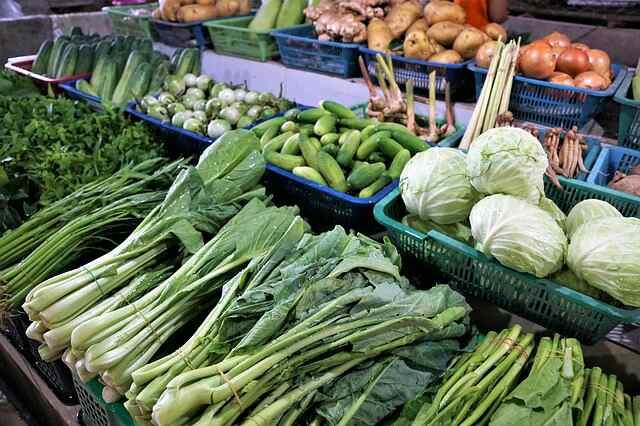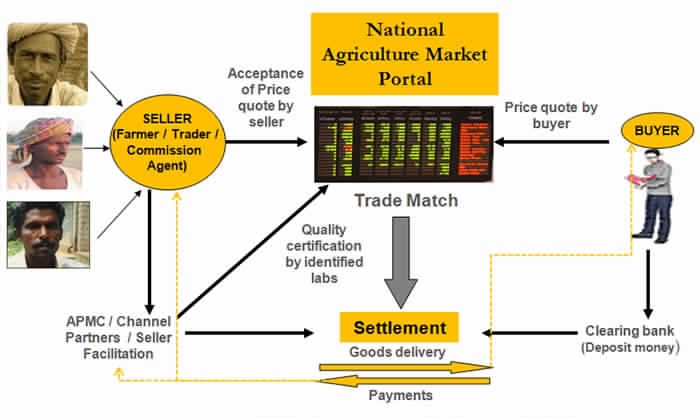Indian Economy – Agriculture – Agricultural Marketing
Introduction

- Agricultural marketing system is an efficient way by which the farmers can dispose their surplus produce at a fair and reasonable price. Improvement in the condition of farmers and their agriculture depends to a large extent on the elaborate arrangements of agricultural marketing.The term agricultural marketing include all those activities which are mostly related to the procurement, grading, storing, transporting and selling of the agricultural produce.
Why Markets are Important
- The country’s food production has increased tremendously from just 51 million tonnes in 1950-51 to about 252 million tonnes in 2014-15. However, farm income did not grow much, as the Situation Assessment Survey of farmers’ households andthe Cost of Cultivation Survey data reveal.
- This was also highlighted by the National Commission on Farmers (NCF) headed by MS Swaminathan. The income realised from cultivation at current prices worked out to be only about ₹101 a day during 2012-13.
- The National Commission on Agriculture (1976) as well as the NCF (2006) had categorically emphasised that higher output alone will not provide higher income to farmers unless it is well marketed.
- Recent incidents of farmers reportedly dumping their bumper produce of tomatoes and onions and emptying cans of milk into drains is clear evidence of it. Had the markets been integrated, the surplus produce would have been transferred to deficit regions. The market integration offers a viable solution to the paradox of plenty.
Present State of Agricultural Marketing in India
Sale in Villages
- The first method open to the farmers in India is to sell away their surplus produce to the village moneylenders and traders at a very low price, The moneylender and traders may buy independently or work as an agent of a bigger merchant of the nearly mandi. In India more than 50 per cent of the agricultural produce are sold in these village markets in the absence of organised markets.
Sale in Markets
- The second method of disposing surplus of the Indian farmers is to sell their produce in the weekly village markets popularly known as ‘hat’ or in annual fairs.
Sale in Mandis
- The third form of agricultural marketing in India is to sell the surplus produce though mandis located in various small and large towns.
- There are nearly 1700 mandis which are spread all over the country. As these mandis are located in a distant place, thus the farmers will have to carry their produce to the mandi and sell those produce to the wholesalers with the help of brokers or ‘dalals’.
- These wholesalers of mahajans again sell those farm produce to the mills and factories and to the retailers who in turn sell these goods to the consumers directly in the retail markets.
Co-Operative Marketing
- The fourth form of marketing is the co-operative marketing where marketing societies are formed by farmers to sell the output collectively to take the advantage of collective bargaining for obtaining a better price.
Regulated Markets
- Organised marketing of agricultural commodities has been promoted throughout the country through a network of regulated markets, whose basic objective is to ensure reasonable prices to both farmers and consumers by creating a conducive market environment for fair play of supply and demand.
Defects of Agricultural Marketing in India
Lack of Storage Facility:
There is no proper storage or warehousing facilities for farmers in the villages where they can store their agriculture produce. Every year 15 to 30 per cent of the agricultural produce are damaged either by rats or rains due to the absence of proper storage facilities. Thus, the farmers are forced to sell their surplus produce just after harvests at a very low and un-remunerative price.
Distress Sale
Most of the Indian farmers are very poor and thus have no capacity to wait for better price of his produce in the absence of proper credit facilities. Farmers often have to go for even distress sale of their output to the village moneylenders-cum-traders at a very poor price.
Lack of Transportation
In the absence of proper road transportation facilities in the rural areas, Indian farmers cannot reach nearby mandis to sell their produce at a fair price. Thus, they prefer to sell their produce at the village markets itself.
Unfavourable Mandis
The condition of the mandis is also not at all favourable to the farmers. In the mandis, the farmers have to wait for disposing their produce for which there is no storage facilities. Thus, the farmers will have to take help of the middleman or dalal who take away a major share of the profit, and finalizes the deal either in his favour or in favour of arhatiya or wholesalers.
A study made revealed that the share of middlemen in case of rice was 31 per cent, in case of vegetable was 29.5 per cent and in case of fruits was 46.5 per cent
Intermediaries
A large number of intermediaries exist between the cultivator and the consumer. All these middlemen and dalals claim a good amount of margin and thus reduce the returns of the cultivators.
Unregulated Markets
There are huge numbers of unregulated markets which adopt various malpractices. Prevalence of false weights and measures and lack of grading and standardization of products in village markets in India are always going against the interest of ignorant, small and poor farmers.
Lack of Market Intelligence
There is absence of market intelligence or information system in India. Indian farmers are not aware of the ruling prices of their produce prevailing in big markets. Thus, they have to accept any un-remunerative price for their produce as offered by traders or middlemen.
Lack of Organisation
There is lack of collective organisation on the part of Indian farmers. A very small amount of marketable surplus is being brought to the markets by a huge number of small farmers leading to a high transportation cost.
Lack of Grading
Indian farmers do not give importance to grading of their produce. They hesitate to separate the qualitatively good crops from bad crops. Therefore, they fail to fetch a good price of their quality product.
Lack of Institutional Finance
In the absence of adequate institutional finance, Indian farmers have to come under the clutches of traders and moneylenders for taking loan. After harvest they have to sell their produce to those moneylenders at unfavorable terms.
Way Forward
- It is time to concede that production and marketing should march together in order to benefit farmers and consumers. Farmers need to be empowered to decide when, where, to whom and at what price to sell. The intermediary culture needs to be scrapped completely. The seasonal spike in prices of perishable commodities that pushes up the food inflation cannot be addressed without market reforms.
- Almost 40 per cent of all fruits and vegetables are lost annually in India between the grower and the consumer mainly due to lack of storage facilities, a weak transportation system and bad roads. Climate change is expected to make the situation worse.
- States alone cannot revamp the agricultural marketing sector, primarily due to paucity of funds and technology.
- Private investment on a massive scale needs to be invited to upgrade and build large storage and warehousing systems that are climate resilient.
- However, sweeping reforms will see light only when agricultural marketing is brought under the Concurrent or Union list with the consent of the States. The country will achieve food security only when the income of farmers is secured and doubled.
Government Interventions
Model APMC Act 2003
Salient Features
- As per the act, the State is divided into several market areas, each of which is administered by a separate Agricultural Produce Market Committee (APMC) which impose its own marketing regulation (including fees).
- Apart from that, legal persons, growers, and local authorities are permitted to apply for the establishment of new markets for agricultural produce in any area.
- There will be no compulsion on the growers to sell their produce through existing markets administered by the Agricultural Produce Market Committee (APMC).
- Separate provision is made for notification of ‘Special Markets’ in any market area for specified agricultural commodities.
- Provision for Contract Farming, allowing direct sale of farm produce to contract farming sponsor from farmer’s field.
- Single point levy of market fee on the sale of notified agricultural commodities in any market area.
- Provision made for resolving disputes arising between private market/ consumer market and Market.
- Provides for the creation of marketing infrastructure from the revenue earned by the APMC.
National Agriculture Market (NAM)

The motivation for a unified market platform can be traced to the Rashtriya e-Market Services (ReMS), an initiative of Karnataka State Agricultural Marketing Board with National e-Markets Limited (NeML), erstwhile National Commodity and Derivatives Exchange (NCDEX) Spot Exchange.NAM, announced in Union Budget 2014-15, is a pan-India electronic trading portal which seeks to connect existing APMCs and other market yards to create a unified national market for agricultural commodities.
Features of NAM:
- NAM is a “virtual” market but it has a physical market (mandi) at the back end
- NAM creates a unified market through online trading platform both, at State and National level and promotes uniformity.
- The NAM Portal provides a single window service for all APMC related information and services.
- While the material flow of agriculture produce continues to happen through mandis, an online market reduces transaction costs and information asymmetry.
Model Mains Question:
1.Discuss the Importance of effective agricultural marketing in doubling farmer’s Income?
Source: Business standard and Discuss Economy











